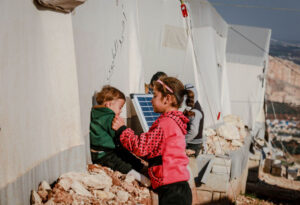Understanding the Effects of War Exposure on Pubertal Development in Syrian Refugee Children
Authors
Annisha Attanayake, Michael Pluess and Candace J. Black.
Key Messages
The Syrian refugee crisis, with children making up 50% of those displaced, highlights the profound impact of war and displacement on child development. This raises significant concerns about the long-term effects on Syrian children’s development. This longitudinal study explores the interplay of how war exposure and limited food resource affect puberty in Syrian refugees, offering insights into the necessity for puberty screening in medical and mental health settings to support trauma-affected youth.
Background
War, Stress, and Pubertal Development: Syrian Refugee Children’s Growth Under Stress
The Syrian Civil War has created one of the largest humanitarian crises in modern history, displacing millions of families. Refugee children, often living in temporary settlements, experience physical hardship and profound psychological trauma. Puberty, a critical period of growth and development, can be particularly sensitive to such stressors. Research indicates trauma can accelerate pubertal development, whereas deprivation often delays it. However, the co-occurrence of war-related trauma and nutritional deprivation remains unclear. This gap underscores the need for further investigation into how these factors shape the development of children exposed to conflict.
What were the aims of this study?
Investigating the impact of war and energetic stress on puberty to inform developmental support for refugee children
The study aim was to understand how war exposure and energetic stress (i.e., nutrition deprivation) influence and/or moderate pubertal development. Based on existing literature, we tested whether the effects of war exposure and malnutrition work independently or interact to affect pubertal timing differently in males and females.
How was this study carried out?
A longitudinal study involving 1,600 child-caregiver pairs displaced in Lebanon
The research was part of the Biological Pathways of Risk and Resilience in Syrian Refugee Children (BIOPATH) project, involving 1,600 child-caregiver pairs living in temporary settlements in Lebanon. Participants included boys and girls aged 8–16 years who had fled Syria within the last four years.
War exposure was assessed using a 25-item questionnaire, which recorded traumatic events such as bombings, kidnappings, and witnessing death. Nutritional stress was measured using Body Mass Index-for-age (BMI), a standard proxy for energetic availability. Pubertal development was tracked through self-reported milestones like menarche for girls and physical changes like voice deepening for boys. Statistical models explored how these variables interacted, highlighting sex differences in responses to stress.
What were the key findings?
Gender differences influence how stress impacts pubertal development
 Results revealed novel findings on the nuanced relationship between war exposure, energetic stress, and puberty in males and females.
Results revealed novel findings on the nuanced relationship between war exposure, energetic stress, and puberty in males and females.
For boys, exposure to life-threatening events, such as witnessing injury or death, was associated with accelerated pubertal timing, but only when nutritional stress was low. When boys faced significant malnutrition, the effects of trauma on puberty were diminished.
For girls, nutritional stress had a more significant role. Higher energetic stress decreased the likelihood of experiencing menarche (the onset of menstruation), aligning with global trends associating malnutrition to delayed puberty. However, contrary to expectations, war exposure did not directly predict the timing of menarche.
Interestingly, for girls who had left Syria more than four years prior, exposure to bombings was linked to delayed menarche. This finding suggests that the long-term impact of trauma may evolve over time, potentially influenced by ongoing stress or recovery in their post-war environments.
What are the implications of this research?
Puberty screening could identify trauma-affected children, enabling early interventions that may mitigate the risk of developing psychopathology
This study provides insight into the significant biological impacts of war and malnutrition on refugee children, including the notable gender differences in pubertal development. For boys, the interplay of trauma and nutrition underscores how early-life adversity can accelerate development under certain conditions. For girls, the critical role of nutrition suggests that targeted interventions, such as improving food provision, could have measurable benefits for their development.
The findings raise important questions for healthcare providers and policymakers. Puberty screening could become an essential tool in identifying trauma-affected youth, offering opportunity for early interventions to prevent the risk of developing psychopathology. However, the study also highlights the limitations of using pubertal development alone as a marker of adversity, particularly in resource-scarce settings.
More broadly, these results emphasise the need for comprehensive, gender-sensitive approaches to support refugee children. By addressing psychological and nutritional needs, we can better equip children facing adversity to thrive despite the challenges that they face.
About the study team
The study was conducted by a team of experts in psychology and mental health including; Candace J. Black, Dr Fiona S. McEwen, Demelza Smeeth, Cassandra M. Popham and Prof Michael Pluess from Queen Mary University of London; and Prof Elie Karam from Balamand University.
References
Candace J. Black, McEwen, F., Demelza Smeeth, Popham, C., Karam, E.G. and Pluess, M. (2023). Effects of war exposure on pubertal development in refugee children. Developmental Psychology, 59(9), pp.1559–1572.
